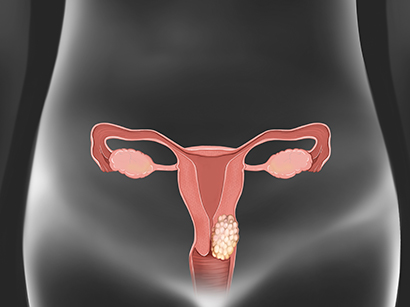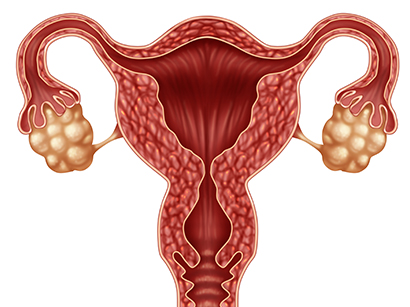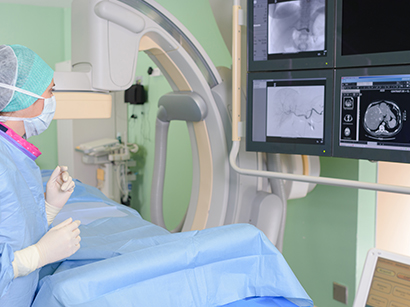Find information on diseases & conditions, and treatment & procedures
Cancer Therapy
Cervical Cancer
Overview
Cervical cancer is a mass or masses of cancerous cells formed in cervix,
the bottom of uterus, connected to the vagina. This cancer is the second
most common type of cancer that kills women worldwide. Exposure to Human
Papillomavirus (HPV), sexually transmitted diseases are known cause of
cervical cancer.


Symptoms
- Typically does not have any symptoms in the early stage
- Bleeding after sexual intercourse, blood like discharge from vagina,
pelvic pain during intercourse can be seen in the advanced stage
Treatments
1. Cervical Cancer Surgery
To cure cervical cancer in early stage, removal of the uterus and cervix is
recommended. In case where the cancer developed further, removal of partial
vagina and lymph nodes is recommended.


1) Process of procedure
- Patients may receive external or internal radiation therapy and chemotherapy
before the surgery.
- Begin general anesthesia (patient's breathing will depend on ventilating machine)
- Empty bladder by catheterization
- Give an incision to the area
- Uterus, cervix, maybe part of vagina and lymph nodes will be removed
- Suture the incision with delicate care
2) Expected duration of hospital stay
- Generally the surgery itself takes one to two hours
- Generally expected hospitalization period is 1~3days including surgery time.
This may differ case by case.
3) Post-operative care
- The patient will be monitored thoroughly in the recovery unit to ensure that he or
she is free of complications (bleeding, infection, excessive pain, abnormal vital signs).
- Patient may get a drain under the operated area which will stay for days.
4) Ideal outcomes
- Patient is back to normal life after six weeks
- Cancer tissues are clearly removed
- Patient's quality of life is improved
5) Risks
- Excessive bleeding, blood clots, infection, death (rare)
6) Treatment cost
- Expected cost ranges from to.
2. Chemotherapy
Usually applied as a supportive treatment to surgery and radiation therapy.
Chemotherapy is delivered via pills and intravenous injection. It significantly decreases
cancer recurrence and metastasis. And it treats recurred or metastasized cancer.
For advanced cervical cancer patients, having increased dose of chemotherapy and
radiotherapy at the same time is recommended.


1) Process of procedure
- Chemotherapy is usually given at outpatient clinic if it is an IV injection
(more common way), or taken at home as pills
- Many patients get a vascular access device which enables safe practice of
chemotherapy in their chest.
- Fasting is required on the day of treatment
- Receive medical examination of vital signs
- Receive chemotherapy via IV
- Recheck vital signs
- Consult about side effects with doctor
- Receive prescribed medication and instructions of after chemotherapy
2) Expected duration of treatment
- Generally hospital visiting period is every once a week or once in three weeks
(depending on patient's recovery time)
- Chemotherapy is delivered through three to six months for early stage cancer,
and beyond six months for advanced cancer. It can vary depending on patient's condition
3) Ideal outcomes
- Matastasis of cancer is prevented.
- The size of cancer mass reduces in accordance with the therapy.
4) Risks
- Nausea, fatigue, loss of hair, inhibited production of blood and blood cells from
bone marrow, decreased white blood cells, fever, infection, mouth sores and damage
in gastrointestinal tract, severe pain, and infertility
3. Radiation therapy
Ionized radiations such as X-ray, protons or others are irradiated internally and externally
to remove cancer cells. It reduces recurrence of cancer after surgery. As it shrinks
the size of cancer, is also effective in relieving symptoms.


1) Process of procedure
- Radiation can be irradiated from inside the body while patient is undergoing surgery
- Radiation can also be irradiated from inside patient's vagina using a device filled with
radioactive substance.
2) Expected duration of treatment
- Generally radiation therapy is delivered to patient five times a week for about five to
six weeks (depending on patient's condition)
3) Ideal outcomes
- Metastasis of cancer is prevented.
- The size of cancer mass reduces in accordance with the therapy.
4) Risks
- Due to temporary intestinal and urinary tract inflammation, there are several acute
side effects can occur as below:
Stomachache, diarrhea, nausea, vomiting, frequent urination, pain when urinating,
blood in urine and feces
- Fatigue, skin may get irritated, swelling of breast and differed skin sensation may occur.
5) Treatment cost
- Expected cost ranges from to.










 Inquiry
Inquiry Find Doctor
Find Doctor
